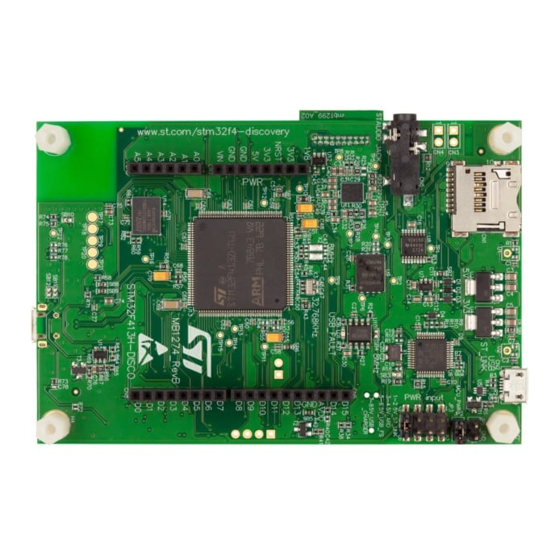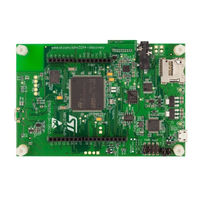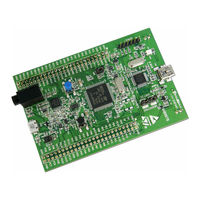
ST STM32F423 Series Manuals
Manuals and User Guides for ST STM32F423 Series. We have 3 ST STM32F423 Series manuals available for free PDF download: Reference Manual, Application Note
ST STM32F423 Series Reference Manual (1324 pages)
advanced Arm-based 32-bit MCUs
Brand: ST
|
Category: Microcontrollers
|
Size: 15 MB
Table of Contents
-
Glossary53
-
I-Bus55
-
D-Bus55
-
S-Bus55
-
Busmatrix56
-
Introduction57
-
Bit Banding62
-
Introduction66
-
Erase72
-
Programming73
-
Interrupts74
-
Option Bytes74
-
Low-Power Modes100
-
Sleep Mode103
-
Stop Mode105
-
Standby Mode108
-
PWR Register Map116
-
Reset117
-
System Reset117
-
Power Reset118
-
Clocks119
-
HSE Clock121
-
HSI Clock122
-
LSE Clock123
-
LSI Clock124
-
RTC/AWU Clock125
-
Watchdog Clock125
-
RCC Registers129
-
For Stm32F413Xx140
-
For Stm32F423Xx141
-
For Stm32F413Xx151
-
For Stm32F423Xx152
-
RCC Register Map181
-
Port Pins194
-
GPIO Registers196
-
(X = a196
-
(X = a197
-
(X = a199
-
(X = a201
-
SYSCFG Registers204
-
(Syscfg_Exticr1)206
-
(Syscfg_Exticr2)206
-
(Syscfg_Exticr3)207
-
(Syscfg_Exticr4)208
-
DMA Introduction214
-
DMA Overview216
-
DMA Transactions217
-
Arbiter219
-
DMA Streams219
-
Circular Mode223
-
Fifo226
-
Flow Controller230
-
Error Management233
-
DMA Interrupts234
-
DMA Registers235
-
DMA Register Map245
-
NVIC Features249
-
EXTI Registers258
-
AHB Interface266
-
Introduction307
-
QUADSPI Pins308
-
QUADSPI Usage317
-
Ncs Behavior320
-
ADC Introduction336
-
ADC Clock338
-
Timing Diagram340
-
Analog Watchdog340
-
Scan Mode341
-
Data Alignment343
-
Data Management347
-
Using the DMA347
-
ADC Interrupts350
-
ADC Registers351
-
DAC Introduction366
-
DAC Data Format368
-
DAC Conversion369
-
DMA Request371
-
Noise Generation371
-
DAC Registers378
-
(Dac_Dhr12L1)382
-
(Dac_Dhr12L2)383
-
(Dac_Dhr12Ld)384
-
(Dac_Dhr8Rd)385
-
DAC Register Map386
-
Introduction388
-
Integrator Unit411
-
Analog Watchdog411
Advertisement
ST STM32F423 Series Reference Manual (1284 pages)
advanced ARM-based 32-bit MCUs
Brand: ST
|
Category: Microcontrollers
|
Size: 14 MB
Table of Contents
-
I-Bus53
-
Programming71
-
Interrupts72
-
Sleep Mode101
-
Stop Mode103
-
Standby Mode106
-
PWR Register Map114
-
Reset115
-
Power Reset116
-
HSE Clock119
-
HSI Clock120
-
LSI Clock122
-
RTC/AWU Clock123
-
RCC Registers127
-
For Stm32F413Xx138
-
For Stm32F423Xx139
-
For Stm32F413Xx148
-
For Stm32F423Xx149
-
RCC Register Map178
-
GPIO Registers193
-
DMA Introduction211
-
DMA Transactions214
-
Arbiter216
-
Circular Mode220
-
Error Management230
-
DMA Interrupts231
-
DMA Registers232
-
DMA Register Map242
-
Block Diagram262
-
AHB Interface263
-
Introduction304
-
QUADSPI Pins305
-
QUADSPI Usage314
-
ADC Introduction333
-
Timing Diagram336
-
Scan Mode337
-
Data Alignment339
-
Data Management342
-
ADC Registers345
-
DAC Conversion362
-
DMA Request364
-
DAC Registers371
ST STM32F423 Series Application Note (50 pages)
Getting started with MCU hardware development
Brand: ST
|
Category: Motherboard
|
Size: 1 MB
Table of Contents
-
-
System Reset13
-
-
4 Package
20 -
Advertisement
Advertisement


